Chicken rearing is a reliable and profitable source of income that you can incorporate in your backyard. The good thing with the venture is that it requires less capital and space to hack. However, to achieve success, you must choose the right chicken breed that suits your needs.
When choosing the chicken breed to rear you should first consider what you want to achieve and what your preferences are. Your answers to these questions will speak volumes about the chicken breed that suits your needs. With all the chicken breeds available in the market, finding one that fits your bill will be a walk in the park.

Chicken Breeds and Their Characteristics
Although there are many chicken breeds in the market, choosing the right breed should not be overwhelming. Once you have all the information you need about the different breeds, choosing a breed that works for you should be an easy thing to do. Read on to find out everything you need to know about the different chicken breeds and their strong points.
Coloured layers Chicken Breed
One of the stark differences that different chicken breeds have is the colour of their eggs. Chicken breeds can either lay coloured, brown, or white eggs. Below are some of the recognized coloured layers of chicken breeds.
Araucana
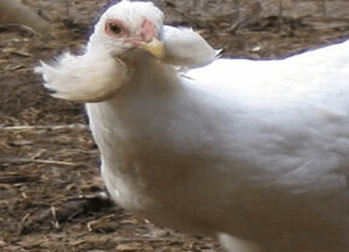
Araucana chicken breed was developed in Chile before the old world contact. This means that they were the only native chicken breed from the Americas. Araucanas have ear tufts but no tail feathers nor muffs and beards.
They are very rare because their ear tufts gene is lethal, which makes it hard for two offspring copies to hatch. When breeding Araucana chicken breed, half of the chicks bred have only one copy of the tufts ear gene, while a third have no tufts. The other third have two copies and therefore cannot survive. Consider yourself a lucky chicken farmer if you own an Araucana chicken breed.
Ameraucana
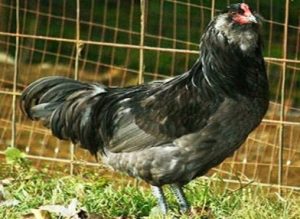
Ameraucana chicken breed was developed in the US in the 1960s to 1970s. They are descendants of the Araucanas brought into the country from Chile. This chicken breed lays blue eggs.
You can recognize them easily because they have a pea comb, black or slate legs, white skin, muffs and beards. They come in different colour varieties including blue, white, silver, black, white, and wheaten. They are fair brooders and have an average laying ability of 250 eggs in a year. They are only available in reputable breeders in the country.
Cream Legbar
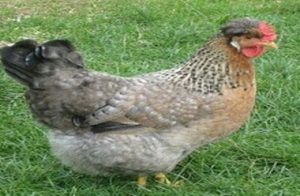
The cream legbar chicken breed was developed in the United Kingdom in the early 1930s. Cambridge University’s geneticists wanted to create a high egg yielding chicken with autosexing traits. You can, therefore, distinguish one day female and male chicks as female chicks have dark brown stripes while rooster chicks have lighter brown stripes.
Cream legbar is easily recognizable because it has silver grey and cream plumage. It has small crests which slope back away from the eyes. They are medium-sized and active foragers that do well in backyard conditions. They can lay an average of 160 to 200 pale green or sky blue eggs each year and do not go broody easily.
Easter Egger
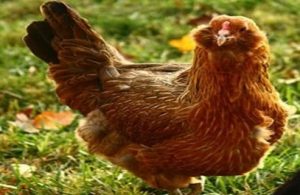
Easter Egger chicken is a relative of the Araucanas and Ameraucanas breeds that lays blue eggs. It is, therefore, a hybrid and not a pure chicken breed. This chicken breed can be cross-bred with any breed provided that one parent has a blue eggs gene.
What makes Easter Egger chicken breed stand out from the rest is its ability to lay eggs of different colours. However, it can only lay one egg colour in its lifetime and have an average egg-laying productivity of 280 eggs in a year, which makes them good layers. They are also a great backyard flock addition.
Isbar
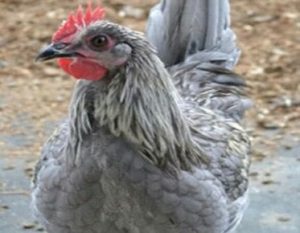
The bar chicken breed was developed in Sweden in 1950s, with the goal to create a high laying chicken with autosexing traits. The breed is not only beautiful, making it a work of art, but also unique and practical. They are hardy in cold weather and great foragers with great alertness to predators.
Their average laying capabilities is 200 eggs in a year and they lay green or speckled brown eggs. Isbar roosters have shimmering metallic hackle feathers and blue body plumage. Splash feather patterns are common in the bar chicken breed which adds variety to their outlook.
Olive Egger
Olive egger is a crossbreed of chicken with dark brown and blue egg genes. They lay varying green shaded eggs depending on their parent breed. The chicken is very hardy in a hot and cold climate and is very active and curious. They are great backyard flock addition.
White Layers Chicken Breeds
Just like the name suggests, white layers are the chicken breeds that lay white eggs. Below are some of the recognized white egg laying chicken breeds.
55 Flowery Hen
The 55 flowery hen was developed in 1955 by Father Martin Silverudd in Sweden. He wanted to create a high laying chicken breed with autosexing traits. This explains why the 55 flowery hen lays large round-shaped eggs that are cream in colour.
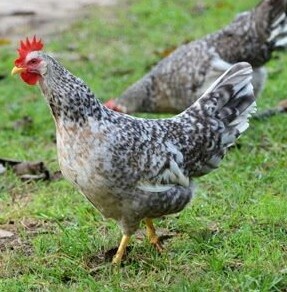
Distinguishing between a rooster and hen chick is easy because roosters have blonde down at their head’s back and are lighter. An adult rooster is white in colour while a hen has a flowery spotted feather pattern.
Ancona
Ancona chicken breed was developed in Italy and it is named after Marche region’s capital, Ancona. It was however developed to have its consistent plumage present today, in the 19th century in England.
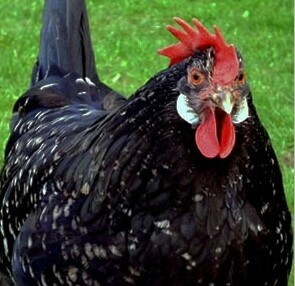
What makes it stand out from the rest is its V-shaped white-tipped beak. The Ancona hen has an average laying capability of 220 white eggs in a year. It is a lively, ranging, rustic, and hardy chicken breed, best suited for the Mediterranean climate.
Andalusian
Andalusian chicken breed, or blue Andalusian as it is commonly known, originated from Spain. They have a slate blue, black, or off-white plumage depending on its genetics. What makes it stand out among the rest are its white earlobes. It has a light body and large pointed comb which makes it ideal in warmer climates.
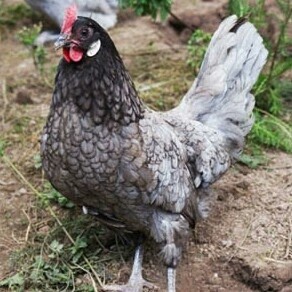
It is an active forager which explains why it is not suited for confinement. An Andalusian hen lays an average of 165 white eggs in a year.
Brakel
Brakel chicken breed was developed in northern France, Holland, and Belgium in 1416. It is a hardy and active breed which is alert to predators, excellent forager, and a good flyer. It has solid silver gold neck plumage and banded feathers with a red comb.
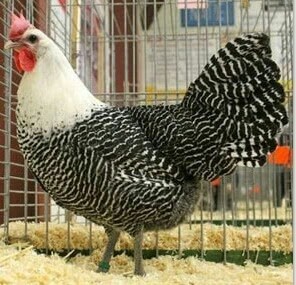
Brakel chicken breed can lay an average of 180 to 200 white eggs in a year.
Cinnamon Queen
Cinnamon queen, or Golden comet as it is commonly known, is a modern chicken breed with white eggs gene. It is a crossbreed of the Rhode Island Red rooster and Rhode Island White hen. They have an autosexing trait with their cockerel chicken being a different colour to that of pullets.
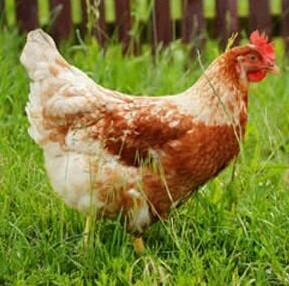
The chicken breed was developed as a prolific egg yielder, with an average laying ability of 250 to 300 eggs in a year. They also start laying eggs early than the other heritage breeds. If you want a chicken breed that is an egg layer, then cinnamon queen should be your ideal choice.
Friesan
The Friesan chicken breed is an ancient breed which is over 1000 years old developed in the northern coast of Netherlands. It is a small chicken breed with excellent flying abilities than the other large chickens. Their plumage comes in different colours namely; Gold, Chamois pencilled, and silver.
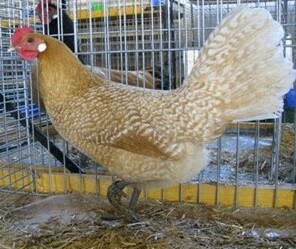
Young Friesan chicks feather and mature quickly when compared to other chicken breeds. It is docile and does not go broody often. It has an average egg production of 150 to 180 white eggs in a year.
Gournay
Gournal chicken breed, or “Le Poule de Gournay” as it is commonly known, was developed in upper Normandy region in France. Its ancient ancestry dates back to the Vikings’ age. A gournay chicken weighs an average of 4 to 7 pounds and has a small head and round body.
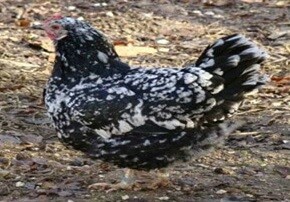
Its plumage is evenly mottled with black and white colour, while their eyes are orange and their beak thick. Its breast is well developed with flavorful and delicate meat. Gournay hens are docile and friendly but do not go broody, and lay three extra-large white eggs in a week.
Gournay chicken breed is easy to tame and does well in confinement, making them a perfect backyard chicken.
Hamburg
Hamburg chicken breed was found in the 14 century in Holland but its origin remains unclear to date. The chicken is known for its high egg yielding ability with an average egg production of 200 white eggs in a year. What sets it apart from the rest is that it lays for longer than the other chicken breeds.
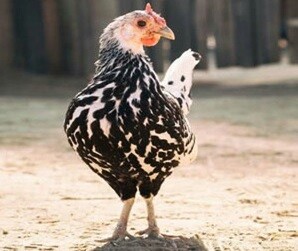
The chicken is a good addition to backyard chicken flock, with no forage room. It is an active, spirited, and robust chicken breed with light eating traits. Their plumage comes in silver spangled varieties adding to their aesthetic look.
Holland
Holland chicken breed was developed by Rutgers Breeding Farms, with the aim of creating a dual-purpose chicken breed with white egg-laying trait. It is a perfect backyard chicken due to its calm and docile nature. It is also a good forager and hens have a good mothering ability when compared to other chicken breeds.
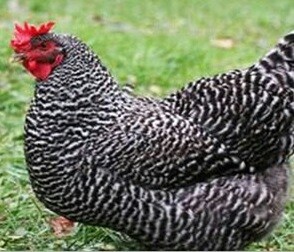
Holland chicken breed is also a good table bird with excellent large eggs laying ability.
Leghorn
Leghorn chicken breed was created simultaneously in the 1850s, in both the United States and England. Its ancestry traces back to the northern Italy chicken breeds. It is a very active bird with great foraging and scratching traits making it a perfect backyard flock addition.
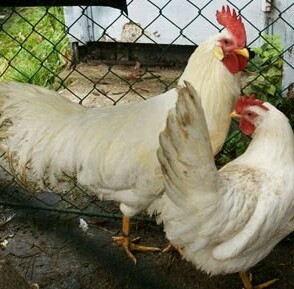
Leghorn chicken breed is easy breeders, hardy, and high egg yielders with an average egg production of 280 to 300 white eggs in a year.
Minorca
Minorca chicken breed is the largest fowl in the Mediterranean region. It comes with a greenish-black glossy plumage, with large and bright red wattles and combs, which helps in dissipating the heat. It also has large almond-shaped white earlobes which are common to Mediterranean chicken breeds.
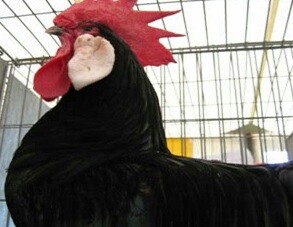
The Minorca chicken breed does not go broody, are excellent egg layers, and an excellent backyard flock addition.
Brown Layers Chicken Breeds
Brown layers are the chicken breeds that lay brown eggs. These chicken breeds are very popular across the world. Below are the brown laying chicken breeds.
Australorp
Australorp was developed at the same time with Orpington. The chicken breed was developed in Australia with the aim of creating a high egg yielder that resembled the Orpinton breed from England. The chicken breed found it difficult distinguishing itself from the Orpington until the 1920s when it was recognized as australorp.
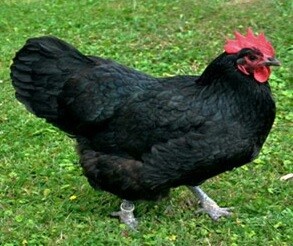
The bird has an average egg production of 250 eggs in a year. However, the egg-laying record for an australorp is 364 brown eggs in a year, without artificial lighting assistance.
Barnvelder
Barnvelder just like the name suggests is named after Barnveld which is a Dutch town. It is medium-sized and dual-purpose chicken breed with excellent foraging traits, thus being an excellent backyard flock addition. The chicken is also hardy and docile with good egg-laying capabilities.
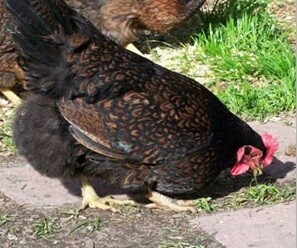
The most popular barnvelder chicken is double-laced feather pattern, which is the original bird. It is well known for its beautiful plumage with copper, metallic green, and black feather colouring.
Bielefelder
The bielefelder chicken breed was developed in the 1970s in Italy by a poultry farmer Gerd Roth. He used genes from Cuckoo Malines, Wyandotte, New Hampshire, and Amrock to crossbreed the chicken breed. The chicken breed has all the good qualities of all the breeds used to create it.
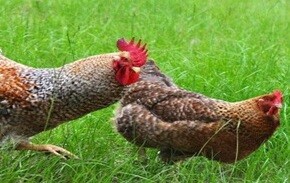
The dual-purpose bird has autosexing trait with female chicks having chipmunk strip at the back, while male chicks have a yellow spot on the head. When they mature, they develop a complicated feather pattern referred to as cuckoo red partridge. The bielefelder birds are friendly, docile, and seek human attention.
They also have a large body frame which holds a lot of meat with rosters weighing an average of 10 to 12 pounds. Hens have an average egg production of 230 eggs in a year. Their eggs are unique in that they are brown in colour with pink spots and undertones.
Black or Red Star
Black Star chicken breed is a crossbreed between barred Rock hen and Rhode Island Red rooster. The red star, on the other hand, is a crossbreed between Rhode Island Red rooster and a Rhode Island White, Silver Laced Wyandotte, Delaware, or White Rock hen. The hybrid has autosexing traits making it easier to distinguish male chicks from a female.

The chicken breed has good egg-laying capabilities with an average of 300 eggs each year. The shade of brown of its eggs varies with the breeds used in the crossbreeding process.
Brahma
Brahma, or King of Poultry as it is commonly known, is one of the largest chickens in the world. It is known for its vigour, strength and size as well as its dual-purpose capabilities. The chicken breed is a great addition to backyard flock due to its foraging trait.
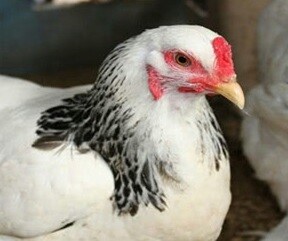
Brahma chicken breed is very hardy in both cold and hot climate and doesn’t have flying abilities due to its large size. It is a docile and calm chicken with great egg-laying abilities during the winter season when other chicken breeds are dormant. Besides being a good layer, Brahma chicken is ideal for meat due to its large body frame.
Buckeye
Buckeye chicken breed was developed by Nettie Metcalf in the 19th century in Ohio, USA. The buckeye is the only America chicken breed that was developed by a lady. She crossbred Barred Plymouth and the Buff Cochins to create lazy and large-sized chicken. The breed is a dual-purpose chicken breed with lustrous red plumage.
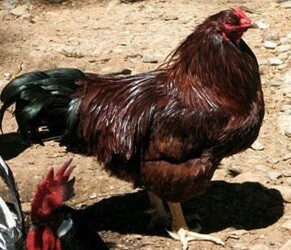
Buckeye chicken breed is hardy during cold seasons and adapts to different living conditions. It is also an active, friendly, and docile chicken with excellent hunting and foraging abilities. The chicken can be distinguished from Rhode Island Red breed due to its pea comb.
Chantecler
Chantecler chicken breed was developed in 1907 by Wilfrid Chatelain in Canada, with the aim of creating a chicken breed suitable to Canada’s climate. Chantecler is a dual purpose large chicken with white feathers that lies tight to the body. It has small cushion wattles and combs, which makes it one of the hardiest chicken breeds in the world.
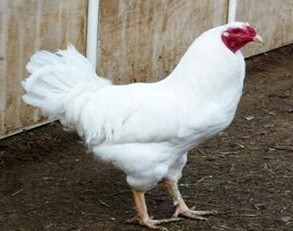
Chantecler is easy to tame but it does not like living in confinements. If you consider rearing this chicken breed therefore, you must have a large garden where it can range freely. Its average egg productivity per year is 200 eggs which are brown in colour.
Delaware
Delaware chicken breed was developed by Gorge Ellis in 1940 in Delaware, just like the name suggests. The chicken breed was initially known as Indian Rivers and originated from a crossbreed of New Hampshire hen and Barred Plymouth Rock rooster. Although the initial intention of creating the bird was meat production, it is a good dual-purpose breed with average egg productivity of 4 eggs in a week.
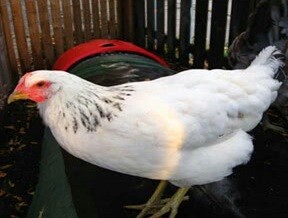
Delaware chicken breed is very calm, friendly, and docile with a beautiful white body plumage and a touch of black neck feathers.
Java
Java chicken breed is one of the oldest chicken breeds in American dating back to 1835. Its ancestors are from Island of Java in the Far East, from which its name was derived from. The chicken breed is an excellent forager thus being a good backyard flock addition.
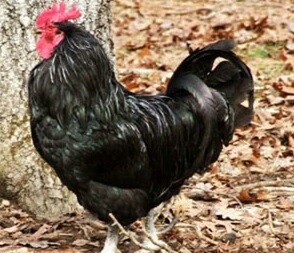
Java chicken is best known for its egg-laying capabilities as well as meat production. It comes in black, mottled, auburn, and white varieties with a beetle green sheen on its plumage.
Jersey Giant
Jersey giant chicken breed was developed in New Jersey, the USA between the year 1870 and 1890. Just like its name suggests, the chicken breed has a big body frame with roosters weighing 13 pounds while hens 10 pounds. It is, therefore, the largest chicken breed that is purebred with a fairly good laying ability of 260 brown eggs in a year.
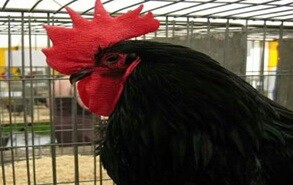
Maran
Maran chicken breed was developed in western France and imported to the USA in the 1930s. The chicken breed comes in 9 recognized colour varieties namely; Cuckoo, Black, Golden Cuckoo, Black Copper, Black-tailed Buff, Birchen, Columbian, and Wheaten. Maran hens are known for their very friendly, docile, and free-ranging traits which make them easy to tame.
Maran chicken breed is a good layer with an average laying capability of 150 to 200 chocolate brown eggs in a year.
Naked Neck
Just like the name suggests, the naked neck is a chicken breed that doesn’t have feathers on its neck. It is also known as Turken, which arose from the confusion that it was a hybrid of a domestic turkey and a hen. The naked neck is a dual-purpose chicken breed with only half of the feathers when compared to other breeds, this makes it easy to pluck them when slaughtering.
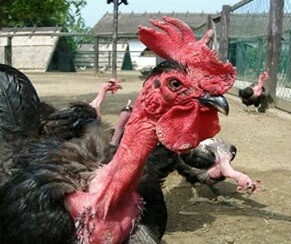
It is also a good brown eggs layer with excellent foraging abilities and immune to the majority of the chicken diseases.
Orpington
Orpington chicken breed was developed in the 1800s by William Cook in Orpington town in England, from which its name is derived. He aims was to create a dual-purpose chicken breed with white skin, which British people preferred. Within the 10 years after its creation, it became popular in America and Britain.
These chickens are tasty when cooked properly in homes and restaurants.
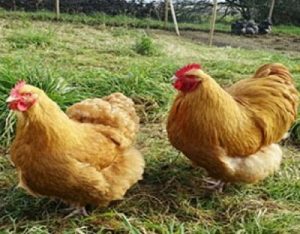
Orpington chicken breed comes in five colour varieties namely; Black, Buff, Spangled, White, and Jubilee. It is a good laying chicken breed with an average egg production of 200 eggs in a year. The Buff Orpingtons are particularly popular due to their docile characteristics, thus making them good pets.
Plymouth Rock
Plymouth Rock chicken breed, which is historically the most popular breed in the United States, was developed in the 19th century in America. The dual-purpose chicken breed has a very beautiful plumage made of white and black striped feathers. It is best known for its docile, broodiness, and high egg production qualities, being excellent for backyard flock addition.
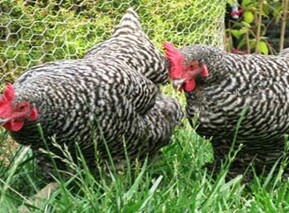
Rhode Island Red
If you are a beginner poultry farmer, the Rhode Island Red chicken should be your first flock. The chicken breed was developed in the 1800s in Rhode Island and Massachusetts, from which it derives its name. Rhode Island Red chicken is not only hardy during hot and wet climate but also low maintenance and dual purpose.
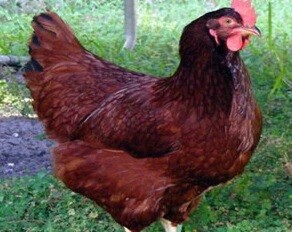
Its hens have a laying capability of 5 to 7 brown eggs in a week.
Speckledy
Speckledy is a modern crossbreed between the Rhode Island Red rooster and Maran hen. The chicken has a feathering resembling that of a cuckoo Maran and is elegantly built. Its feathers are soft, abundant, fluffy, and silky which adds to its beautiful plumage.
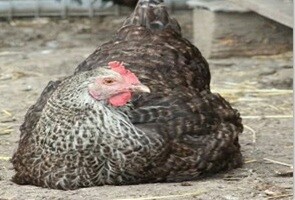
The chicken has pale legs and eyes, small wattles and earlobes, and a single medium-sized comb. Incubating eggs of these chickens are great for hatchers. It is a docile bird which is easy to tame and handle, with good foraging traits thus well suited in a free-ranging environment. The average egg production of speckledy is 250 to 270 chestnut speckled brown eggs in a year, with strong eggshells and deep yellow yolks.
Sussex
Sussex is a dual-purpose chicken breed that dates back to 43 A.D but reached the United States in 1912. The chicken has the ability to gain fat very easily, thus, you should be careful on the amount and type of feeds you give it. Its weight gain affects its egg-laying productivity and that is why you should check on their feeds.
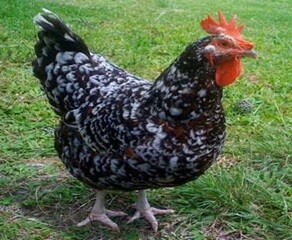
Sussex chickens come in different colour varieties namely; Specked, Light, and Red, and are very active. The chicken has good egg-laying capabilities of 250 brown eggs in a year.
Welsummer
Wel summer chicken breed was developed in the 1920s in Dutch. The chicken is not only friendly but also intelligent, thus being easy to tame and control. It comes with an orange and rustic red plumage adding to its aesthetics. Wel summer hens lay dark terracotta brown eggs that are often speckled.
Wyandotte
Wyandotte chicken breed was developed in the 1880s and named after the Native American tribe in the upper parts of Ontario, Canada and New York, USA. They are a hybrid of spangled Ham burgs and Dark Brahma. Silver Laced Wyandotte chicken was the first to be recognized, but the Buff Columbian, Silver Penciled, Blue Buff, Columbian, Partridge, golden laced, and Black Wyandotte have since been recognized.
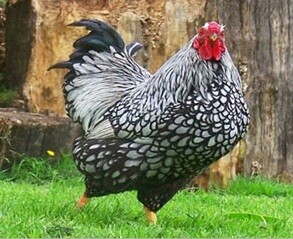
Wyon dette chickens are generally docile, friendly and calm which makes them easy to tame. They are also hardy and great mothers with average laying productivity of 200 brown eggs in a year.
Crested Chicken Breeds
In case you like crested chicken breeds, you have a wide array of chicken breeds that you can choose from. Below are the crested chicken breeds available in the market.
Appenzeller
Appenzeller chicken breed was developed in Switzerland and comes in two varieties namely; The Spitzhauben and The Barthuhner. The Spitzhauben chicken variety is named after a woman hat and comes with a feather crest and V comb. The Barthuhner, or the bearded hen as it is commonly known, on the other hand, has rose comb but no crest.
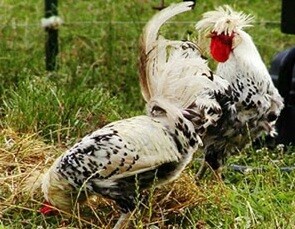
The appenzeller chicken comes in different colour varieties including black, silver spangled, and golden spangled. This chicken breed is ornamental but it lays a good number of eggs in a year. Its foraging traits and small body frame make it a free-ranging chicken.
Brabanter
Originating from Belgium and Netherlands, the Brabanter chicken breed was developed back in the 17th century. The chicken has a small body frame with a crest similar to that of the appenzeller and a V-shaped comb. It is an average winter layer as it lays a good number of eggs during winter. You can keep them in a small nesting box for their small aspects.
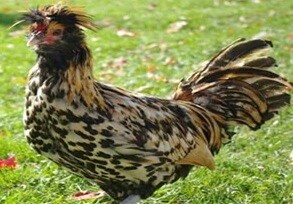
Brabanter is an intelligent but calm chicken that is suited in cold climatic conditions. Its small wattles and comb enable it to avoid frostbite attack.
Crevecoeur
Crevecoeur chicken breed was developed in France. Its name is derived from a town in Normandy which means a broken heart. Although the chicken breed is popular in France, other countries have not fully embraced it.
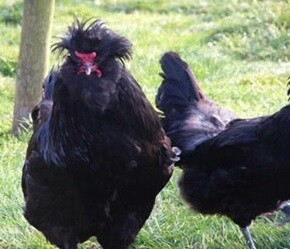
Crevecoeur chicken comes in solid black plumage with a V-shaped comb. It is generally quiet and docile, a good meat yielder, and a moderate layer recording an average of 120 white eggs in a year.
Houdan
Houdan chicken was also created in France and is a descendant of 5-toed Fowl, common in Belgium and France. The chicken is used both for meat and egg production, as it is dual-purpose breed. It has both beards and crest and comes with beautiful mottled white feathers.
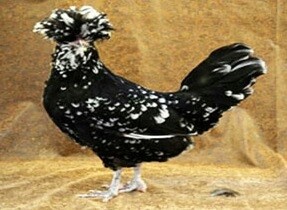
Just like its ancestors, the Houdan chicken has five toes in each foot and is moderately hardy.
Polish
Polish chicken has a distinguishable crest that covers the whole of its head. Its origin is unclear but was standardized in the Netherlands. The chicken was imported into the United States in 1830 and has since become fairly widespread.
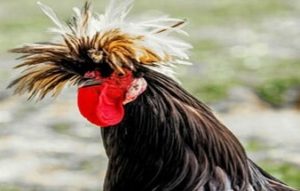
Polish chicken was originally bred to be a productive white eggs layer. In recent times, it is considered more as an ornamental chicken than a layer, due to its unique look. The chicken is shy, skittish, and vulnerable to predators because its crest obscures its vision.
Sultan
Sultan chicken, or Serai Taook as it is commonly known to mean “Fowl of the Sultan’s Palace”, is a turkey native. The chicken was introduced in England in 1854 after Elizabeth Watts who was the editor of Poultry Chronicles received a couple of them from a friend.
The chicken is particularly unique due to its V-shaped comb, beards, crest, vulture hocks, five toes, muffs, large nostrils, and feathered shanks. So, you will special automatic door for the box and coops if you want to breed them.
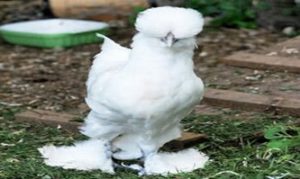
Sultan has pure white feathers, slate blue legs, and happy personality, which makes it an ornamental bird. It also lays white eggs and can be good meat yielders due to their dual-purposefulness. It is generally a good backyard flock addition.
Bantam Chicken Breeds
In case you are looking for bantam chicken breeds, the good news is that there is a host of them in the market today, as outlined below.
Barbu D’uccle
Barbu D’uccle chicken was developed in Uccle town which is located in the outskirts of Belgium capital Brussels. The chicken has muff, beards, and hackle feathers, making it easily distinguishable. The chicken comes in seven varieties including Self Blue, Black, Porcelain, Golden Neck, White, Mottled, and Mille Fleur, which is the most popular variety.
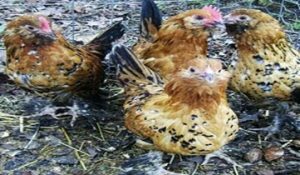
The chicken has a friendly disposition and is known for its quirky and mysterious expressions. Its hen lays tiny eggs that are cream in colour and do well in confinements.
Belgian Antwerp D’anvers
Belgian Antwerp D’anvers was developed in the 1600s making it one among the oldest bantam chicken breeds. It has an upright body, arching tail, and round breasts which make it easily distinguishable. It also has a profuse feather beard and a rose comb.
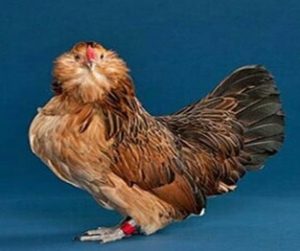
Belgian Antwerp D’anvers roster weighs around 24 ounces while the hen weighs 21 ounces and has a free-ranging and friendly personality.
Booted Bantam
Booted bantam is also referred to as “Sabelpoot” in Netherlands and “Federfluflge Zwerghuhne” in Germany. It is easily distinguishable due to its extravagant toe and feet feathering. Its roosters weigh about 27 ounces while hens 22 ounces.
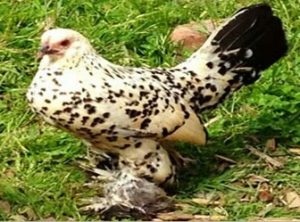
Booted bantam is a calm, docile, and friendly chicken making it a good pet. It is also a good forager best suited for free-ranging conditions.
Chabo
Chabo chicken breed, which is one of the largest bantam chicken breeds, is also referred to as Japanese bantam. It has a hefty and upright tail, short legs, and comes in different colour varieties. Its roosters averagely weigh over a pound while hens under a pound
Dutch Bantam
Just like the name suggests, Dutch Bantam originated from the Netherlands. It is one of the smallest bantam chicken breed averagely weighing 15 ounces, which enables them to easily fly.
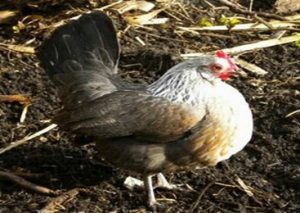
Its hens can averagely lay about 160 cream eggs in a year and have friendly and docile characteristics making them great pets.
Pekin Bantam
Penkin Bantam chicken originated from china and is believed to have been brought to England by the British soldiers after looting the emperor of china. What makes them stand out among the rest is their round shape with many feathers, making their feet invisible. Their rooster weighs about 23 ounces while hens 20 ounces.
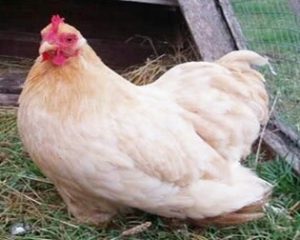
Peking Bantam comes in different colour varieties and is docile and friendly birds which are easy to tame. Although they are not excellent layers, they go broody quickly and make good mothers.
Pyncheon
Pyncheon chicken was developed in the northeastern part of the United States around the 1700s. The chicken is easily recognizable due to its single comb that folds into S letter shape. It also has a tassel that is similar to that of a crest only that its feathers protruding out behind its comb.
The chicken has a mille fleur feather pattern with reduced black stippling and has a great flying ability due to its small size. Its hen lays small cream or white eggs and go broody quite easily but don’t make good mothers rather ideal incubators. The chicken is very friendly making it a good pet.
Rosecomb Bantam
Rosecomb Bantam is a pure bantam chicken breed developed around the 14th century in England. Its rooster averagely weighs around 26 ounces while its hen around 22 ounces. The chicken is mainly reared for the exhibition because of its unique appearance.
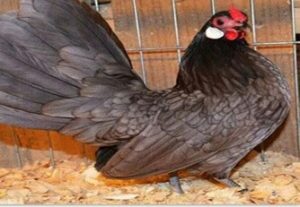
Rosecomb Bantam mainly comes in three colour varieties namely; White, Black, and Blue. What makes the chicken stand out from the rest is its large earlobes and comb as well as their characteristics of standing tall, proud and alert. The rose comb bantam is docile but not friendly, lays only one cream egg in a week, and requires high maintenance.
Sebright
Named after its creator, the Sebright chicken was developed around the 1800s in England by Sir John Sebright. It is a true bantam chicken because it doesn’t have another standard version. It is generally a small bird for bantam because its roosters averagely weigh around 22 ounces.
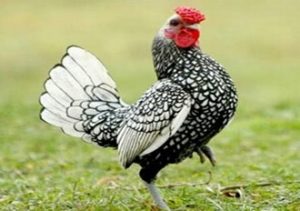
The chicken is kept for ornamental purposes due to its beautifully laced silver gold plumage. Sebright roosters do not have the typical feathering in their tail, hackles, and saddles and are very active and easy to tame, making them ideal pets.
Scots Dumpy
Scots Dumpy chicken was developed in Scotland. The word dumpy means the dwarfing gene which makes the chicken waddle when walking, due to its short legs. The chicken is docile, an excellent egg producer goes broody easily, and makes good mothers. Its roosters crow at the first sign of dawn, making them the perfect alarm clocks.
Bottom Line
With all the chicken breeds available in the market to choose from, choosing the breed to rear can be a hard nut to crack. However, all the chicken breeds outlined above have their benefits and uses. That is the reason why you should take your time, before settling on the breed that suits your needs.
When making your choice, you need to first determine what your purpose of rearing the chicken is. You will also need to consider the available space that you have to rear them, as different breeds need a different amount of space. In addition, you will need to consider the weather patterns in your area, as some breeds do well in certain climatic conditions than others.
When all is said and done, the best chicken breed to rear depends on your interests and needs.
